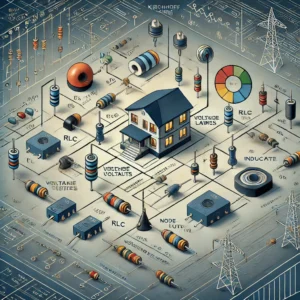EC Notes Pdf – Electric Circuits JNTUH Free Lecture Notes
Here you can download the free lecture Notes of Electric Circuits Pdf Notes – EC Notes Pdf materials with multiple file links to download. The Electric Circuits Notes Pdf – EC Pdf Notes book starts with the topics covering Voltage and Current sources, network reduction techniques, R.M.S and Average values and form factor for different periodic wave forms, series R-L, R-C, R-L-C and parallel combination with variation of various parameters, Faraday’s laws of electromagnetic induction, Basic cutset and Basic Tieset matrices for planar networks, Superposition, Etc.

ELECTRIC CIRCUITS Notes (EC)
Electric Circuits Pdf Notes – EC Notes Pdf
Please find the download links below
Objective :
This course introduces the basic concepts of circuit analysis which is the foundation for all subjects of the Electrical Engineering discipline. The emphasis of this course is laid on the basic analysis of circuits which includes Single phase circuits, magnetic circuits, theorems, transient analysis and network topology.
Latest Material Links
Complete Notes
Link – Complete Notes
Unit 1
Link – Unit 1 Notes
Unit 2
Link – Unit 2 Notes
Unit 3
Link – Unit 3 Notes
Unit 4
Link – Unit 4 Notes
Unit 5
Link – Unit 5 Notes
Old Material Links – Electric Circuits Notes Pdf – EC Pdf Notes
EC-Electric-Circuits
Download EC-Electric-Circuits here
EC-Phasors
Download EC-Phasors here
EC-ResistiveCircuits
Download ResistiveCircuits here
EC-Transformers
Download EC-Transformers here
EC-Energy Storage
Download EC-EnergyStorage here
EC-First Order Circuits
Download EC-FirstOrderCircuits here
EC-OpAmps
Download EC-OpAmps here
EC-Circuit Theorems
Download EC-Circuit Theorems here
EC-Basic Laws
Download EC-BasicLaws here
EC-Basic Concepts
Download EC-BasicConcepts here
EC-Analysis Methods
Download EC-AnalysisMethods here
UNIT – I
Introduction to Electrical Circuits
Circuit Concept – R-L-C parameters – Voltage and Current sources – Independent and dependent sources-Source transformation – Voltage – Current relationship for passive elements ( the diff input signals, square , ramp, saw tooth, triangular )
UNIT – II
Kirchhoff’s laws – network reduction techniques – series, parallel, series parallel, star-to-delta or delta-to-star transformation. Nodal analysis, mesh analysis, super node and super mesh for D-C excitation.
UNIT – III
Single Phase A.C Circuits
R.M.S and Average values and form factor for different periodic wave forms, Steady state analysis of R, L and C (in series, parallel and series parallel combinations) with sinusoidal excitation – Concept of Reactance, Impedance, Susceptance and Admittance – Phase and Phase difference – concept of power factor, Real and Reactive powers – J-notation, Complex and Polar forms of representation, Complex power
UNIT – IV
Locus diagrams & Resonance
Locus diagrams – series R-L, R-C, R-L-C and parallel combination with variation of various parameters – Resonance – series, parallel circuits, concept of band width and Q factor.
Electric Circuits Pdf Notes – EC Notes Pdf
UNIT – V
Magnetic Circuits
Magnetic Circuits – Faraday’s laws of electromagnetic induction – concept of self and mutual inductance – dot convention – coefficient of coupling – composite magnetic circuit – Analysis of series and parallel magnetic circuits
UNIT – VI
Network topology:
Definitions – Graph – Tree, Basic cutset and Basic Tieset matrices for planar networks – Loop and Nodal methods of analysis of Networks with independent voltage and current sources – Duality & Dual networks.
UNIT – VII
Network theorems (with D.C)
Tellegen’s, Superposition, Reciprocity, Thevenin’s, Norton’s, Maximum Power Transfer, Millman’s and Compensation theorems for d.c. excitations.
UNIT – VIII
Network theorems (with A.C)
Tellegen’s, Superposition, Reciprocity, Thevenin’s, Norton’s, Maximum Power Transfer, Millman’s and Compensation theorems for A.c. excitations.
TEXT BOOKS: Electric Circuits Pdf Notes – EC Notes Pdf
- Engineering circuit analysis by William hayt and jack e kemmerly McGraw Hill ;
- Circuits & networks by a.sudhakar and shyammohan s pillai TMH
- Electric circuits by a chakravarthy dhanipat rai & sons
REFERENCE BOOKS: Electric Circuits Notes Pdf – EC Pdf Notes
- Network analysis by m e an lakenberg
- Linear circuit analysis (time domain phasor and laplace transform approaches) second ed. By Raymond a decarlo oxford press 2004
- Network theory n c jagan & c lakshiminarayana 2006, BSP.
- Electric circuit theory by k raeshwaran, PE 2004
- Basic circuit analysis by d.r. Cunningham & j.a. stuller, jaico
Note :- These notes are according to the r09 Syllabus book of JNTUH.In R13 ,8-units of R09 syllabus are combined into 5-units in r13 syllabus.Click here to check all the JNTU Syllabus books
Electric Circuits Notes PDF (EC Notes) – B.Tech Notes 2025 (JNTUH)
Looking for Electric Circuits Notes PDF for your B.Tech studies at JNTUH? We’ve compiled a comprehensive guide with links to download Electric Circuits (EC) Notes PDF for free. These lecture notes are perfect for students of Electrical Engineering, focusing on the fundamental concepts of circuit analysis, which are essential for understanding various advanced subjects in the field.
Electric Circuits (EC) Notes PDF provides in-depth coverage of topics such as voltage and current sources, network theorems, transient analysis, and much more, making it an invaluable resource for your studies.
Overview of Electric Circuits Notes PDF (2025)
Electric Circuits (EC) is a core subject in Electrical Engineering, laying the groundwork for understanding more advanced topics. The subject covers a wide range of concepts including single-phase circuits, magnetic circuits, various network theorems, and transient analysis. These concepts are crucial for both academic and practical applications in the field of electrical engineering.
In this post, you can find Electric Circuits Notes PDF for free download, with multiple file links for easy access. Whether you’re studying the latest syllabus (R13) or earlier versions like R09, these notes will help you grasp the subject thoroughly.
Electric Circuits PDF Lecture Notes – JNTUH
These Electric Circuits Notes are designed to assist students at Jawaharlal Nehru Technological University Hyderabad (JNTUH) in understanding the key principles of circuit analysis. The lecture notes include detailed explanations, diagrams, and solved problems to enhance your learning experience.
Electric Circuits Notes PDF | EC B.Tech Notes (2025)
Download Electric Circuits (EC) Notes to get detailed explanations of concepts such as:
- Voltage and current sources
- Network reduction techniques
- RMS and average values
- Series and parallel combinations of RLC circuits
- Faraday’s laws of electromagnetic induction
- Network theorems like Thevenin’s and Norton’s
These Electric Circuits Notes PDF are updated according to the 2024 syllabus for B.Tech students at JNTUH, ensuring that you have the latest information at your fingertips.
Description: Electric Circuits PDF, Syllabus, Books | B.Tech (2025)
- Overview: The Electric Circuits (EC) Notes PDF provides detailed explanations and diagrams for all key topics covered in the syllabus. These notes are structured to facilitate easy understanding, whether you are preparing for exams or working on practical applications.
- Topics Covered: From basic circuit elements to advanced network theorems, these notes cover everything you need to excel in your coursework. Below, we’ve provided a breakdown of the topics included in each unit.
The Following Topics are Covered in Electric Circuits (EC) Handwritten Notes
Unit 1: Introduction to Electrical Circuits
- Circuit concept
- RLC parameters
- Voltage and current sources (independent and dependent)
- Source transformation
- Voltage-current relationships for passive elements
- Input signals such as square, ramp, sawtooth, and triangular waves
Unit 2: Kirchhoff’s Laws & Network Reduction Techniques
- Series, parallel, and series-parallel networks
- Star-to-delta (or delta-to-star) transformations
- Nodal and mesh analysis
- Super node and super mesh analysis for DC excitation
Unit 3: Single-Phase A.C. Circuits
- RMS and average values for periodic waveforms
- Steady-state analysis of RLC circuits with sinusoidal excitation
- Concept of reactance, impedance, and admittance
- Power factor, real and reactive power
- J-notation, complex power, and polar forms of representation
Unit 4: Locus Diagrams & Resonance
- Series and parallel RLC circuits
- Locus diagrams
- Resonance, bandwidth, and Q factor
Unit 5: Magnetic Circuits
- Faraday’s laws of electromagnetic induction
- Self and mutual inductance
- Dot convention and coefficient of coupling
- Analysis of series and parallel magnetic circuits
Unit 6: Network Topology
- Graphs and trees in networks
- Basic cutset and basic tieset matrices
- Loop and nodal methods of analysis
- Duality in electrical networks
Unit 7: Network Theorems (DC)
- Superposition, Thevenin’s, Norton’s, Maximum Power Transfer, and Millman’s theorems
- Reciprocity and compensation theorems
Unit 8: Network Theorems (AC)
- Application of network theorems for AC circuits, including Thevenin’s, Norton’s, and Tellegen’s theorems
Topics Covered in Electric Circuits (EC) Notes PDF
- Voltage and current sources
- Network reduction techniques (star-delta transformation)
- AC and DC circuit analysis
- Kirchhoff’s laws
- RMS and average values
- Power factor, impedance, and admittance
- Resonance and locus diagrams
- Magnetic circuits and network topology
- AC and DC network theorems
Electric Circuits Notes PDF from JNTUH
These notes have been curated based on the syllabus followed at Jawaharlal Nehru Technological University Hyderabad (JNTUH). You can be assured that they are comprehensive and up-to-date, following the latest curriculum (2024).
Always Choose Smartzworld to Download Electric Circuits Notes PDF
Smartzworld is your go-to platform for downloading the best Electric Circuits Notes PDF. We offer easy-to-access download links, regularly updated materials, and free resources to help you excel in your studies.
Benefits of Free Electric Circuits Handwritten Notes PDF
- Comprehensive Coverage: The notes cover all essential topics required for the exams.
- Easy to Download: All notes are available for free download with a single click.
- Well-Structured: Handwritten notes provide a clear and concise explanation of each topic.
- Updated Content: Stay ahead with the latest syllabus and exam patterns.
FAQs: Electric Circuits (EC) Notes PDF
Q1. Where can I download the Electric Circuits Notes PDF?
You can download the notes from the provided links for each unit or the complete set from Smartzworld.
Q2. How to download the EC Notes PDF?
Click on the links provided for each unit or complete notes to start the download.
Q3. How many modules are covered in Electric Circuits Notes PDF?
The notes cover 8 modules, corresponding to various key topics in Electric Circuits (EC).
Q4. Topics Covered in EC Notes PDF?
Topics include circuit elements, network theorems, AC and DC circuits, magnetic circuits, resonance, and more.
Q5. Where can I get the complete Electric Circuits Handwritten Notes PDF free download?
The handwritten notes can be downloaded for free from Smartzworld, where all resources are available.
Q6. How to download EC Handwritten Notes PDF?
Simply follow the links provided on the page for free and easy access to EC Handwritten Notes.
Q7. How to Download Free EC Notes PDF?
Visit the Smartzworld website and click on the provided links to download the free EC Notes PDF.
This guide offers a complete overview and access to all Electric Circuits Notes PDF resources for B.Tech students at JNTUH.


